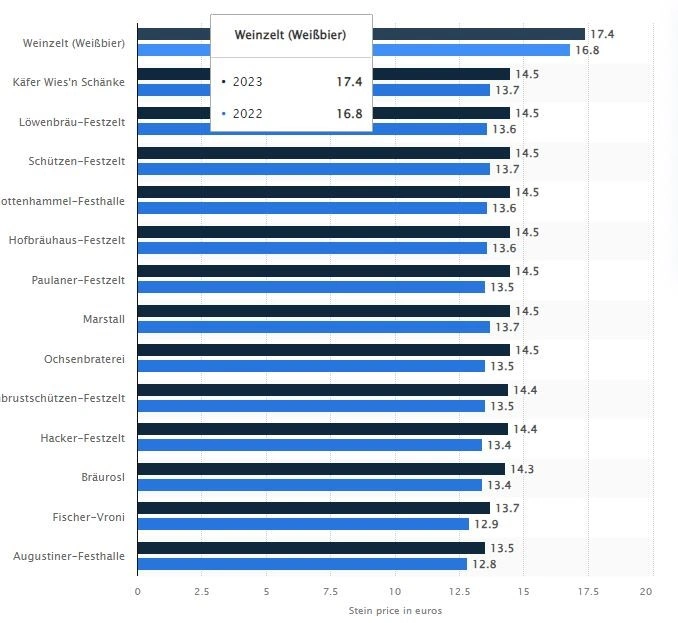[ad_1]
Oktoberfest, the world-renowned beer festival held annually in Munich, Germany, is a local celebration and attracts millions of tourists worldwide. The festival is famous for its types of beers from all famous Munich breweries, traditional German culture perseverance, captivating folk outfits like Dirndl and Lederhosen men, and relish feast, making it a bucket-list event for many.
Do you know?
7.2 million guests visited Oktoberfest in 2023, to enjoy 18 days of festivities. 15% of visitors attend Oktoberfest from foreign countries, including surrounding EU countries and non-European countries such as the United States, Canada, Australia, New Zealand, and East Asia.
Here is a pictorial representation of the attendees, making it a perfect tourist attraction in Germany.

But what exactly draws such a vast international crowd to this Bavarian festival making it a great tourist attraction in Munich?
A Glimpse into Oktoberfest’s Attractions
Here are all the details that make Oktoberfest a great tourist spot.
Festival’s Heart And Soul: Beer Tents
By name, it may look like an ordinary tent, which is unfair to say. These vast, elaborately decorated halls can host thousands of people at a time. When talking about the beer tents at Oktoberfest, there are many options, including small and large ones;
Armbrustschützenzelt – A huge tent that accommodates 5,830 people seated inside. This tent is famous for its crossbow competition that is held every year.
Schottenhamel – By 1950, the Schottenhamel tent had gained prominence, hosting the official Tapping of the Keg ceremony, started by Mayor Thomas Wimmer. Today, the Schottenhamel tent, known for attracting a stylish, primarily German crowd, including politicians, celebrities, and students, accommodates 10,000 people. It offers traditional foods like half-chicken, unique dishes like giant turkey legs, and Spatenbräu beer.
Ochsenbraterei – Ochsenbraterei welcomes you with massive OX roasting on a spit. In a fraction of time, the meat will be gone and there will only be bones. It’s time to put another OX on the spit for another meal for the coming hungry Oktoberfest pedestrians.
Marstall – This comes with a modern approach to lively brass band music, we serve freshly poured beer, but also fine wines; the menu offers regional specialties as well as sophisticated cuisine. The Marshall is a stylish setting for celebrating, seating over 4,000 guests – 3,200 inside the tent and 1,000 in the beer garden.
| In 2023, the price of a stein or Maß of beer at the Oktoberfest in Munich in Germany increased significantly compared to the previous year. Prices varied in tents at the carnival, but the most expensive Maß could be found in the Weinzelt, where weissbier was served. |
Based on various tents, here is a detailed graph of how beer prices rose.

Traditional Bavarian Music
The traditional Bavarian music at Oktoberfest is far more than just a soundtrack to the event. It is an integral component that animates the festivities, celebrates and preserves Bavarian culture, fosters a sense of community, and enhances the overall experience of this renowned festival.
At the heart of this musical tradition are the Oompah bands, named for the characteristic sound of their brass and woodwind instruments. These bands typically feature a blend of instruments, including trumpets, trombones, tubas, clarinets, and sometimes accordions, contributing to their distinctive sound. The musicians, often dressed in lederhosen for men or German Dirndl dress for women aka traditional Bavarian attire, add a visual element to the auditory experience, reinforcing the cultural authenticity.
The Cultural Significance of Oktoberfest
“Oide Wiesn” is a special section of the Oktoberfest in Munich that celebrates traditional Bavarian culture and heritage. A large population is attracted to Oktoberfest because of its Bavarian culture and how it is shown throughout the event.
The name translates to “Old Oktoberfest” and was first introduced in 2010 to mark the 200th anniversary of the festival. Unlike the main Oktoberfest, known for its lively and bustling atmosphere, Oide Wiesn focuses on historical aspects, offering a more relaxed and family-friendly environment.
Visitors can experience vintage fairground attractions, traditional Bavarian music, folk dancing, and historical displays. It features classic beer tents that serve old-style Bavarian dishes and beers, often in ceramic steins. The area is designed to replicate the look and feel of the early 20th-century Oktoberfest, providing a nostalgic experience for visitors. It’s an ideal place for those interested in the traditional and cultural roots of the famous Munich beer festival.
The traditional dress – Women wear German dirndls, a type of dress comprising a bodice, blouse, full skirt, and apron, with variations in style and color often representing different regions or marital status.
Lederhosen for men is a short knee-length dress made of pure leather, typically black or brown. However, with cultural variation and with time, traditional dresses have undergone many changes.
The official German attire is not just a costume but a symbol of pride and a connection to history, allowing locals and tourists to immerse themselves in Bavarian tradition.
Oktoberfest Menu to Compliment Beer
The gastronomy delight aka food festival at Oktoberfest is a crucial part of the experience, offering a deep dive into the heart of Bavarian cuisine.
Some of the biggest sellers are roasted half chickens (Hendl), pork knuckles (Schweinshaxe), oxen, and bratwursts of all kinds (just put any ol’ word you want in front of –wurst), all served with the greatest sides this side of Heaven—sauerkraut, red cabbage, potato dumplings, potato salad, and now we’re officially starving. And you can’t forget about the most popular Oktoberfest food – a Bavarian soft pretzel the size of your face.
Oktoberfest features an extensive range of food, from savory to sweet.
The sweet offerings at Oktoberfest add a different dimension to the food experience. Apple strudel, a pastry filled with sweet, spiced apples and gingerbread hearts (Lebkuchenherzen), often decorated with icing and affectionate phrases, is not just a dessert but also part of the festive atmosphere.
Conclusion
This fusion of entertainment and cultural immersion sets Oktoberfest apart from other global festivals, drawing visitors from all corners of the world each year. The tourist attraction celebrates Bavarian heritage and fosters a sense of international community as people from diverse backgrounds come together to share in the joy and camaraderie that Oktoberfest uniquely offers. It’s a testament to how a local tradition can transcend borders and become a cherished festival worldwide.
FAQS
Is Oktoberfest Paid?
Not at all; anyone at the venue can visit it for free. However, you have to pay for the tents and beer, and each varies.
Are children allowed to visit Oktoberfest?
Yes, children of all ages are allowed to visit Oktoberfest. However, children under 16 are subjected to visit beer tents after 8 accompanied by their parents or guardian only.
Read Also:
Must-Known Time-Saving Tourist Tips For Oktoberfest
25 Best Cities for Solo Travel in 2024
Discovering Brazil’s Soul: A Journey Through Art and Culture

Ferona Jose is a passionate travel writer and blogger at Travelistia. She has traveled throughout Europe, Asia and the Americas. Her writing focuses on cheap travel destinations, travel experiences, cultural insights, and travel hacks.
[ad_2]